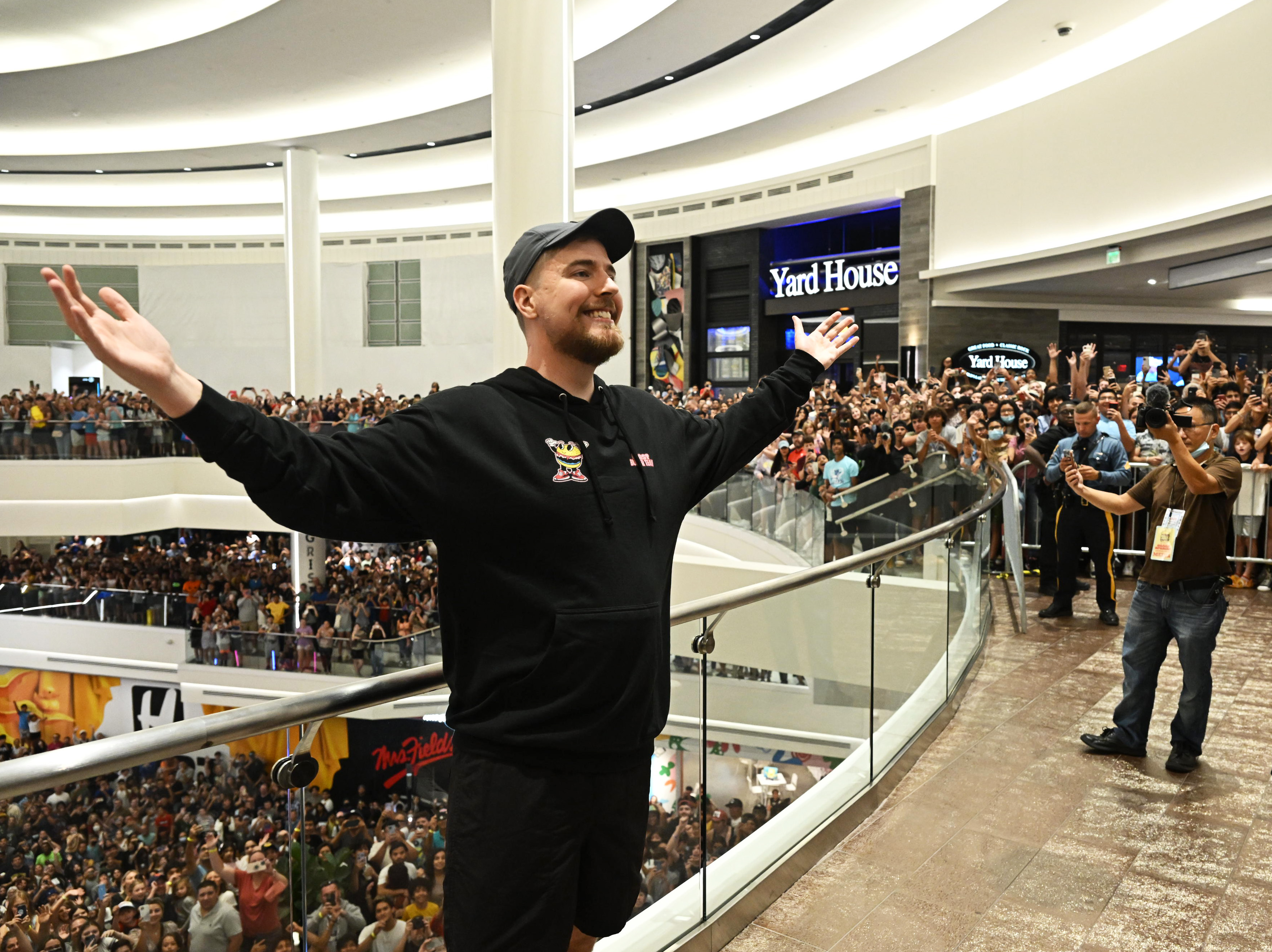Understanding "mr Capone E": A Look Into Mixed Realities And More
Have you ever typed something into a search bar, maybe a little quickly, and then wondered what on earth came up? Perhaps you were looking for something quite specific, and a few stray letters changed everything. So, too it's almost, with the search term "mr capone e." It is that, a phrase which might initially bring to mind a historical figure or a curious mystery. Yet, when we look at what this phrase often points to in the digital space, we find something entirely different, something truly exciting in the world of technology.
You know, it turns out "mr capone e" usually leads us to a fascinating area: the world of "MR," which most often means Mixed Reality. This technology, really, is a blend of what we call Augmented Reality (AR) and Virtual Reality (VR). It takes the best parts from both, leaving behind what might not work as well. We are going to talk about what makes MR so special, and how it stands apart from its cousins, AR and VR. This way, you can get a clearer picture of these immersive digital experiences.
As a matter of fact, the term "MR" itself can be a bit of a chameleon, meaning different things in various contexts. While our main focus today will be on Mixed Reality, we'll also touch upon some other meanings of "MR" that pop up, just to clear things up. This article aims to help you understand these concepts better, giving you a good grasp of what these technologies are all about and why they matter in our daily lives, and stuff.
Table of Contents
- Unraveling MR: The Mixed Reality Story
- Beyond the Tech: Other Faces of MR
- The Future of Immersive Experiences
- Frequently Asked Questions About MR
Unraveling MR: The Mixed Reality Story
When someone searches for "mr capone e," they might actually be looking for information on "MR," which most commonly refers to Mixed Reality. This technology is a big step forward in how we interact with digital content. It brings together the real world and digital creations in a very special way. It's not just about seeing things, but about truly engaging with them, you know.
Basically, Mixed Reality creates a new kind of environment where digital things and real-world things exist together. This means you can see computer-generated objects right there in your own room, and even move them around or change them. It's a bit like magic, but it's all about clever technology, actually.
What is Mixed Reality?
MR, or Mixed Reality, combines the real world with virtual objects. It makes a new space that you can see and interact with. This is a key point, as a matter of fact. It is that, the ability to interact with digital items as if they were truly there in your physical space. Think about being in a store, wearing an MR device. You could see all the sale prices floating next to items. You could also watch the entire construction of that store, from the first plans to the finished building, as if you were part of the project itself. This is a very immersive experience, to be honest.
This technology is really about merging the digital and the physical. It lets you keep some of the real world while bringing in virtual elements. It can also change parts of the real world into something virtual. This means a lot for how we learn, work, and even play, in a way.
AR, MR, and VR: A Simple Comparison
It's often helpful to look at AR, MR, and VR side by side to see their differences. So, we can sum up each one with a simple idea. This helps you pick the right one for what you need. Each has its own strengths, you know, and they serve different purposes. They are all about creating different kinds of digital experiences, really.
Augmented Reality (AR) puts virtual things on top of the real world. For example, you might look at a real book. With AR, you could "stick" virtual labels on its pages. Then, if you scan the book, a 3D image might pop out to explain things. It's about adding to your view of reality, not replacing it, as a matter of fact.
Virtual Reality (VR), on the other hand, creates a completely new, virtual world. When you put on a VR headset, you are fully immersed in a digital space. You don't see your real surroundings at all. It's like stepping into another place entirely. This can be very powerful for games or training simulations, you know.
Mixed Reality (MR) is where the real and virtual truly mix. The main difference between MR and AR is that MR allows for a free switch between virtual and real. You can keep reality in your virtual view, or turn reality into something virtual. If you and a friend are in a room, and you see a virtual object that isn't really there, using a phone or AR glasses, that's AR. But with MR, that virtual object can interact with the real furniture, or you might even be able to pick it up virtually and place it on a real table. This makes it more interactive, obviously.
MR technology mixes real and virtual objects to make new visual spaces that you can interact with. AR often shows information, but it doesn't always let you interact much. VR makes a totally new virtual place. MR, however, makes some virtual objects that sit on top of or combine with real things, allowing for stronger interaction. It's a bit like having digital items truly present in your physical space, and stuff.
How MR Works in Practice
Microsoft's HoloLens glasses are a good example of MR technology. These glasses can put virtual things right into your real world view. They also let you interact with those virtual things. You could, for instance, have a virtual screen floating in your living room and use your hands to move windows around on it. This is pretty cool, honestly.
MR is seen as a different approach for mobile devices. It could even take the place of phones someday. It's almost like if you have VR, you pretty much have AR too, in a way. Microsoft's MR designs are for mobile platforms, preparing for what's coming next. Typically, when something new is about to get big, money flows into it about 20 years early. Then, it might calm down a bit, like what happened with artificial intelligence in the 90s. Now, 20 years later, it's really picking up. MR seems to be on a similar path, you know.
Beyond the Tech: Other Faces of MR
While "MR" most often refers to Mixed Reality in the tech world, the provided text also shows that "MR" can mean other things. This highlights how abbreviations can sometimes lead to different ideas. We're going to explore some of these other meanings found in the text, just to show the variety, you know.
MR in Medical Settings
Sometimes, "MR" refers to Magnetic Resonance, especially in a medical context. For example, the text mentions "Medicolegal aspects of MR safety." This is talking about the safety rules and legal points related to Magnetic Resonance imaging, or MRI scans. These scans are very important for seeing inside the body. It is that, a different kind of "MR" entirely, but equally important, really.
You know, doing a Nuclear Magnetic Resonance check usually costs around 600 to 800 units for a basic one. But some can be over 2000 units. The price depends on what the patient's health issue is and if they need a special "enhanced" check. Hospitals have clear price lists, approved by higher-level price setting groups. Different hospitals might have slightly different prices, but they won't be wildly off. So, you don't need to worry about unfair charges, basically.
Learning from Experience in MR Practice
The text also talks about "Learning from the mistakes of others" in "your own mr practice." This, again, points to the medical field, likely about MRI procedures. The goal is always to learn how to lower the chances of similar problems happening with your own patients. It's about being very careful and constantly getting better at what you do, you know. This kind of learning is vital for patient well-being, honestly.
Hospital Imaging Processes
In some hospitals, like the one mentioned in the text, the imaging center has a set way of doing things. After a scan is taken, the doctor on duty writes a report. Then, a more experienced doctor checks it. If there's a scan that raises questions, the head doctor looks at it personally the next day. They also explain and discuss it with the other doctors. This process helps doctors get better at their work. As a matter of fact, the reason why reports are often ready the next day is to reduce issues between patients and medical staff. It just makes things smoother, you know.
Other Uses of MR and Similar Abbreviations
The text also includes some things that don't directly relate to Mixed Reality or Magnetic Resonance. For instance, it talks about "mmr mechanism" in games, which is about matchmaking ratings. It says, "mmr mechanism: I carry, I can win. elo mechanism: the more I carry, the worse my teammates." This is a completely different meaning of "MMR," showing how an abbreviation can be very specific to its field. It's interesting how the same letters can mean so many different things, you know.
There's also a mention of a "Mechanical Revolution 16super" laptop. This is a brand name, not an abbreviation, but it shows up in the same collection of text. It's about finding the "gaming control panel" after reinstalling the system. This just goes to show how varied the source material is, and how many different things "MR" or similar sounds can bring up, you know. This is just a little bit of extra context from the provided text, really.
The Future of Immersive Experiences
The push for Mixed Reality, as we've seen, is strong. Companies are investing a lot in this area. It's clear that these technologies are not just fads; they are becoming a bigger part of how we live and work. The ability to blend digital content with our real surroundings opens up many new possibilities. It's a bit like having a digital assistant that can show you things right in front of your eyes, you know.
We are seeing more devices, like the Microsoft HoloLens, that make MR a reality. These devices are getting better all the time, becoming more comfortable and offering more detailed experiences. The growth of these technologies suggests a future where our interaction with computers will be much more natural and integrated into our daily lives. It's a very exciting time for technology, as a matter of fact. You can learn more about Mixed Reality on Microsoft's site, for instance.
The journey from a simple search term like "mr capone e" to a deep dive into Mixed Reality, and even a quick look at other uses of "MR," shows how broad and interesting the world of technology and abbreviations can be. These immersive technologies are still developing, but their potential is huge. They are poised to change many parts of our lives, from how we shop to how we learn. Learn more about immersive technology on our site, and link to this page for a deeper look at virtual worlds.
Frequently Asked Questions About MR
People often have questions about these new technologies. Here are a few common ones, just to help clear things up, you know.
What is the main difference between AR and MR?
The main difference is that AR usually adds virtual things to your view of the real world, but you don't always interact with them deeply. MR, however, lets virtual things interact with real things, and you can switch between seeing real and virtual elements more freely. It is that, a bigger sense of interaction, really.
Is MR just a fancy name for AR?
No, they are not the same. While AR is a part of the broader immersive tech family, MR goes a step further. It's about true blending and interaction between the digital and physical, not just overlaying. So, it's more than just a new name, honestly.
What are some common uses for Mixed Reality today?
Today, MR is used in many areas. It helps with training, like for surgeons or mechanics. It's also used in design and architecture, letting people see virtual models in real spaces. Gaming and entertainment are also big areas for MR. These are just a few examples, you know, and the list keeps growing.

Why Phoebe Waller-Bridge Left 'Mr. and Mrs. Smith'

Mr. Olympia results 2022: Complete list of winners for every men's

Not Everyone Is a Fan of MrBeast's New Video | TIME